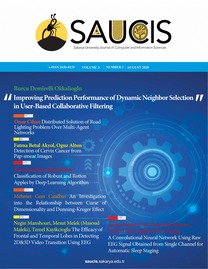Makine Öğrenmesi ile Ürün Kategorisi Sınıflandırma
Product Category Classification with Machine Learning
___
[1] A. H. Aliwy ve E. H. Abdul Ameer, “Comparative Study of Five Text Classification Algorithms with their Improvements”, International Journal of Applied Engineering Research, 2017.[2] H. Alshalabi, S. Tiun, N. Omar, M. Albared, “Experiments on the Use of Feature Selection and Machine Learning Methods in Automatic Malay Text Categorization”, Science Direct, Procedia Technology, Elsevier, 2013.
[3] I. Hmeidi, M. Al-Ayyoub, N. A. Abdulla, A. A. Almodawar, R. Abooraig, N. A. Mahyoub, “Automatic Arabic Text Categorisation: A Comprehensive Comparative Study”, Journal of Information Science, 2015.
[4] C. C. Aggarwal ve C. X. Zhai, “A Survey Of Text Classification Algorithms”, Mining Text Data, Chapter 6, 2012.
[5] H. Deng, Y. Sun, Y. Chang, J. Han, “Probabilistic Models for Classification” C.C. Aggarwal (Eds.), Data Classification Algorithms and Applications (pp. 67-70), CRC Press, New York, USA, 2015.
[6] J. D. Rennie, L. Shih, J. Teevan, D. Karger, “Tackling the poor assumptions of naive bayes text classifiers” Proceedings of the Twentieth International Conference on Machine Learning (ICML- 2003), Washington DC, 2003.
[7] D. G. Kleinbaum, ve M. Klein, “Logistic Regression: A Self-Learning Text (Statistics for Biology and Health)”, Third Edition. New York: Springer 2010.
[8] G. Louppe, “Understanding Random Forest”, doktora tezi, University of Liege, 2015.
[9] S. C. Albright, W. L. Winston, ve C. Zappe, “Data Analysis & Decision Making”, Üçüncü Baskı, Australia: Thomson South-Western, 2006.
[10] S. R. Gunn, “Support vector machines for classification and regression”, Technical Report, Faculty of Engineering, Science and Mathematics, School of Electronics and computer Science, 1998.
[11] J.M. Zurada, “Introduction to Artificial Neural Systems”, West Publishing Company, 1992.
- ISSN: 2636-8129
- Yayın Aralığı: Yılda 3 Sayı
- Başlangıç: 2018
Deep Learning Performance on Medical Image, Data and Signals
Derin Öğrenme Algoritmalarını Kullanarak Görüntüden Cinsiyet Tahmini
Gül GÜNDÜZ, İsmail Hakkı CEDİMOĞLU
A New Genre Classification with the Colors of Music
Vücut Alan Ağları için Enerji Hasadı Ünitesi Tasarımı
ALİ ÇALHAN, Köksal GÜNDOĞDU, Murtaza CİCİOĞLU, MUHAMMED ENES BAYRAKDAR
Makine Öğrenmesi ile Ürün Kategorisi Sınıflandırma
Computer-Aided Detection of Lung Nodules in Chest X-Rays using Deep Convolutional Neural Networks
